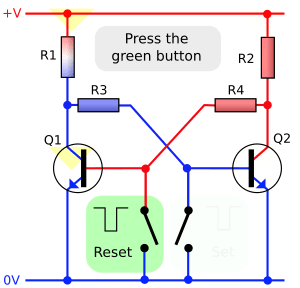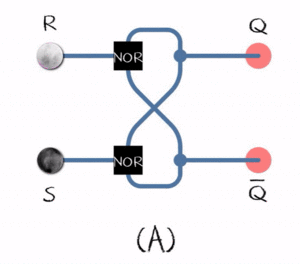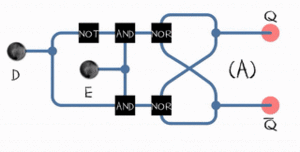Flip-flop (electronics) facts for kids
A flip-flop or latch is a special electronic circuit. It has two stable states, like a light switch that is either ON or OFF. This circuit can store information, usually a single bit (a 0 or a 1). Think of it as a tiny memory cell.

Flip-flops are super important in digital electronics. They are the basic building blocks for things like computers, phones, and many other electronic systems. They help store data, which is represented as binary numbers (1s and 0s). In binary, a "1" means a "high state," and a "0" means a "low state."
Contents
History
The first electronic flip-flop was invented in 1918. Two British scientists, William Eccles and F. W. Jordan, created it. They called it the Eccles-Jordan trigger circuit. It used two vacuum tubes, which were early electronic components. Later, a scientist named Eldred Nelson came up with the name "JK" for a type of flip-flop.
How Flip-Flops Work
Flip-flops can be simple or clocked. A simple flip-flop changes its state as soon as its input changes. These are often called latches.
A clocked flip-flop is different. It only changes its state when an extra signal, called a clock signal, arrives. Most of the time, when people say "flip-flop," they are talking about these clocked circuits.
Types of Flip-Flops
There are different kinds of flip-flops. The two most common types are the SR ("set-reset") flip-flop and the D ("data" or "delay") flip-flop.
SR Flip-Flop
The SR flip-flop is one of the most basic types. In "SR," the "S" stands for "set," and the "R" stands for "reset." The information it stores is shown on its output, which is usually labeled "Q."
Here's how it works:
- If the S input gets a "high" signal (a 1) and the R input stays "low" (a 0), the Q output will be forced "high" (1). This is called "setting" the flip-flop.
- If the R input gets a "high" signal (1) and the S input stays "low" (0), the Q output will be forced "low" (0). This is called "resetting" the flip-flop.
- If both S and R inputs are "low" (0), the Q output stays in its current state. It "holds" the information.
- If both S and R inputs are "high" (1), this is a problem! It's called a "forbidden state" because it can lead to an unstable or unpredictable output.
D Flip-Flop
The D flip-flop is designed to solve the problem of the "forbidden state" in an SR flip-flop. It only has one input for data, which is called "D."
The D flip-flop takes this single "D" input and splits it into two paths. On one path, it flips the data to the opposite value (like a "NOT" gate). This clever design makes sure that the internal SR latch inside the D flip-flop never receives the "forbidden" combination where both inputs are "high" (1). This makes the D flip-flop very reliable for storing single bits of data.
Images for kids
-
An animation of a SR latch, constructed from a pair of cross-coupled NOR gates. Red and black mean logical '1' and '0', respectively.
See also
 In Spanish: Biestable para niños
In Spanish: Biestable para niños









